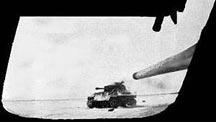| Red
Vengeance: A Preview
By William Sariego
November 2014
I never saw myself as a game designer, yet
alone the designer of a series of games. I
have always enjoyed playing wargames first
and foremost, and then tinkering with them
a bit with variants and such. Scotland
the Brave was designed almost on a dare
by an old friend, and for the longest time
appeared to be a one-shot 15 Minutes of Fame
type deal. Not too long after would see me
take pen to paper and come up with Ragnarok,
a roleplaying supplement. It went on to
be nominated for three Origins Awards, but
like the Mighty Casey of baseball fame, I
struck out! That got my confidence up, however,
and an excessively cold Kentucky winter back
in 2001, which gave me little else to do with
my time, resulted in what would be Defiant
Russia.
A little over a year after that was published
the sequel, Red
Vengeance, saw publication. With
Defiant Russia having sold well, and
launching a new mini-game genre at Avalanche
Press, Herr Dr. Bennighof and company encouraged
a follow up, the exact nature of which was
left to my design taste. I was in the middle
of another project, also involving Russia,
so the sequel was put off a few months. When
I began, many would express surprise at my
choice of time frame. Defiant Russia deals
with Operation Barbarossa, the start of the
war between Nazi Germany and the Soviet Socialist
Republics on June 22, 1941. It seemed like
a cool idea for the follow up to deal with
the conclusion of the war. Operation Bagration
would likewise begin on June 22, three years
later. Taking place just weeks after D-Day
in France, this was clearly Nazi Germany’s
last gasp: the Gotterdamerung, if you will.
This presented an interesting design issue.
At this point, with the two-front war in full
swing (okay, three counting Italy) a glaring
fact stood out for game play. The German player
would realistically have no chance of “winning”
in any conventional sense. There would be
no dramatic turning of the tide, the Ardennes
and Lake Balaton offensives not withstanding.
It was an interesting design issue for a non-professional
game designer; how to make such a losing situation
for one player into a good game.
| 
An SU-85 destroys a German Panther during
the 1944 offensive.
|
Since these Designer’s Notes come as a
preview of Red Vengeance, I don’t
want to give away too much to ruin any surprise
value. To win, the Soviet player is going to
have to pretty much sweep the map by the end
of the April 1945 turn, something not required
of the Germans in Defiant Russia. The
number of Victory Points possible are six; scoring
for control of key cities (Vienna, Prague, Berlin),
liberation or not liberation of Yugoslavia,
Hitler’s state of health (like the point
for Stalin in Defiant Russia), and casualties.
With six Victory Points a draw is possible,
reflecting the Cold War aftermath.
Germany starts out with a good army on paper,
with a lot of Panzer corps. Now most of these
units were Panzer corps in name only, but
I gave the German player the benefit of Hitler’s
fantasy world as the reality was pretty scary,
at least for the Hitlerites. You will see
the Nazis melt away soon enough. The Red Army
is quite strong and quality is much improved
over 1941, but that won’t stop horrendous
casualties as the Germans put up a stout defense.
Like Defiant Russia, naval factors
are not ignored, and some effects of the war
in the west add nice chrome.



Some changes to the basic rules make this
more than a Defiant Russia clone. Gone
are the railways, along with their map aesthetics.
They are replaced by new rules for supply
and strategic movement. Air power has an interesting
twist, and weather effects for winter turns
hurt both sides.
How does it play? Fun and fast would be my
answer. The Germans frantically try to rebuild
new lines of defense along the Vistula and
later the Oder as the Soviets steadily advance
westward. Fighting in the Balkans and the
economics of the oil fields comes into play.
Just when the Soviet player may be smug enough
to feel assured of victory, game effects in
January 1945 reflect the logistical problems
facing the USSR at that moment, including
reduced replacement and strategic movement.
Is it balanced? The Dice Gods tell all,
but using history as a judge, as the game
ends at the conclusion of the April turn,
the Soviets have a 4-2 win. The USSR had captured
Vienna, liberated Yugoslavia, scored the casualty
point, and Hitler had taken the coward’s
way out. The Germans still “held”
Berlin and controlled Prague. In our alpha
testing, before turning the game over to the
Avalanche gang, a 3-3 result was quite common.
Only once did the Soviets run the table, and
I witnessed more than one 4-2 German win!
I hope you enjoy my game. It has been a
pleasure to design it for you. I am moving
beyond the Rodina now for different historical
eras.
Express your solidarity with the Red Goblin! Order Red Vengeance today!
|
